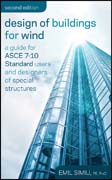
Design of buildings for wind: a guide for ASCE 7-10 standard users and designers of special structures
Simiu, Emil
ASCE 7 is the US standard for identifying minimum design loads for buildings and other structures. ASCE 7 covers many load types, of which wind is one. The purpose of this book is to provide structural and architectural engineers with the practical state-of-the-art knowledge and tools needed for designing and retrofitting buildings for wind loads. The book will also cover wind-inducedloss estimation. This new edition include a guide to the thoroughly revised, 2010 version of the ASCE 7 Standard provisions for wind loads; incorporate major advances achieved in recent years in the design of tall buildings for wind;present material on retrofitting and loss estimation; and improve the presentation of the material to increase its usefulness to structural engineers. Key features: New focus on tall buildings helps make the analysis and design guidance easier and less complex. Covers the new simplified design methods of ASCE 7-10, guiding designers to clearly understand the spirit and letter of the provisions and use the design methods with confidence and ease. Includes new coverage of retrofitting for wind load resistance and loss estimation from hurricane winds. Thoroughly revised and updated to conform with current practice and research. ÍNDICE: Preface. Chapter 1. Introduction. Part A. Guide to the ASCE 7-10 Standard Provisions on Wind Loads. Chapter 2. ASCE 7-10 Wind Loading Provisions. Chapter 3. Regular and Simplified Approach: Risk Category, Basic Wind Speed,Enclosure, Exposure, Topographic Factor. Chapter 4. Regular Approach: Steps Common to All Building/Other Structures, MWFRS and CDirectional Procedure). MWFRS. Chapter 6. Regular Approach: Low-Rise Buildings, Parapets, Overhangs (Envelope Procedure). MWFRS. Chapter 7. Regular Approach: Structures Other Than Buildings. MWFRS. Chapter 8. Simplified Approach: Enclosed Simple Diaphragm Buildings, Parapets, Overhangs. MWFRS. Chapter 9. Regular and Simplified Approach: C&C. Part B. Wind Engineering Fundamentals. Chapter 10. Atmospheric Circulations. Chapter 11. The Atmospheric Boundary Layer. Chapter 12. Extreme Wind Speeds and Wind-Induced Effects. Chapter 13. Bluff Body Aerodynamics Basics. Aerodynamic Testing. Chapter 14. Structural Dynamics. Chapter 15. Aeroelasticity. Chapter 16. Structural Reliability Under Wind Loading. Chapter 17. Loss Estimation. Part C. Wind Effects on Buildings. Chapter 18. Rigid Buildings. Chapter 19. Tall Buildings. Part D. Appendixes. Appendix A1. Random Processes. Appendix A2. Mean Wind Profiles and Atmospheric Boundary Layer Depth. Appendix A3. Spectra of Turbulent Velocity Fluctuations. Kolmogorov Hypothses. Appendix A4. Wind Directionality Effects, Outcrossing and Sector-by-Sector Approaches. Appendix A5. Report on Estimation of Wind Effects on the World Trade Center Towers. References.
- ISBN: 978-0-470-46492-2
- Editorial: John Wiley & Sons
- Encuadernacion: Cartoné
- Páginas: 352
- Fecha Publicación: 21/09/2011
- Nº Volúmenes: 1
- Idioma: Inglés
